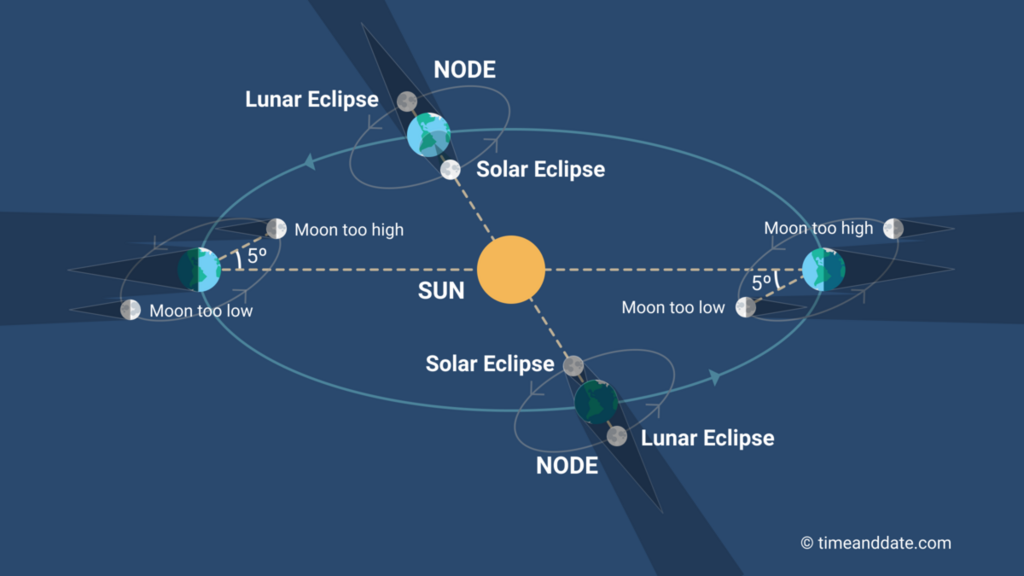Get your cameras ready for the 15th of May !
It’ll be worth staying up late or waking up early on the night of Sunday 15th May to Monday 16th May!
On that date, the stars will align – well, actually, the Sun, Earth and Moon will. The Moon’s orbit is tilted with respect to the ecliptic, the plane in which the Earth orbits the Sun. This means that it’s only on the particular occasion when the Moon’s orbit intersects with the ecliptic (a point astronomers call a node) and when we have a Full Moon that a lunar eclipse can occur. In that case, the Moon finds itself inside the Earth’s shadow, but since our atmosphere scatters light at shorter, bluer wavelengths more than redder light, more red light will reach the Moon. That’s why during lunar eclipses the Moon appears red, and why these events are also known as Blood Moons.

Ancient Greek natural philosophers were able to use lunar eclipses to measure the diameter of the Moon and the Earth-Moon distance fairly accurately. A key property that is evaluated by contemporary researchers is the Moon’s soil’s conductivity, notably how deep radiation at different wavelengths goes and how much of it is retained. In another experiment, during an eclipse in 2019, the Hubble Space Telescope tested a method to observe the sunlight reflected from the Moon, which had first passed through the Earth’s atmosphere. Analysis of the data then successfully revealed the presence of ozone in our atmosphere. This technique is similar to what telescopes have to do when looking at exoplanetary atmospheres, and detecting ozone in one of these could be a sign of extra-terrestrial biology.
Timings for observers on the American continent Timings for observers in the UK/Europe/Africa
Just a few days ago on April 30th, observers in parts of South America, Antarctica and the Pacific had the chance to observe a partial solar eclipse. Historically, solar eclipses have served various research purposes, just like their lunar counterparts: in 1868 for instance, French astronomer Janssen discovered the element Helium when taking the spectrum of a solar prominence. Some decades later, Einstein’s theory of General Relativity received support from the observation that lines in the Sun’s spectrum are redshifted due to the Sun’s gravitational field. What is of much interest nowadays is that during total solar eclipses, it is possible to study the Sun’s atmosphere (the corona) in greater detail, which can notably give insight into the formation and behaviour of the solar wind. This stream of charged particles can have dramatic impacts on our modern civilisation.

Partial solar eclipse on the 30th April, seen at sunset in this zoomed in view from Argentina Early stages of the eclipse seen from Chile, with clearly visible sunspots 
NASA Solar Dynamics Observatory imaged a solar flare on the 30th April,
as our Sun becomes more and more active
Even the latest partial eclipse is a reminder of our star’s power, as observers counted a high number of sunspots. These, and also numerous solar flares in April, are indicative of the Sun’s increasing activity as part of its 11-year cycle, since it currently tends towards its peak activity which will be reached in 2025. The next solar eclipse in October of this year will also be a partial one, with predictably more sunspots into the bargain; for a total one you will have to wait until April 2023 and find yourself in Australia or South East Asia. In terms of the one in October 2023, the Moon will be very close to its apogee (furthest point from Earth during its orbit), so that the lunar disc won’t completely cover the Sun and there will be a beautiful annular eclipse for observers in almost any part of the American continent.
For research or for the pleasure of the eyes - save the date to not miss these alignments !
Cover Image: Lunar Eclipse on 28 September 2015 from the UK, S. Phillips (Equipment: Skywatcher Skymax 127 EQ-5, Canon 450d, Backyard EOS)
Image Credits:
1 - Lunar nodes, timeanddate.com
2 - US Observers Timetable, space.com
3 - UK Observers, P. Lawrence
4 - View from Argentina, timeanddate.com/Latinoamericano de Astroturismo
5 - View from Chile, timeanddate.com
6 - Solar flare on April 30th, NASA/SDO
7 - Upcoming solar eclipses, timeanddate.com
